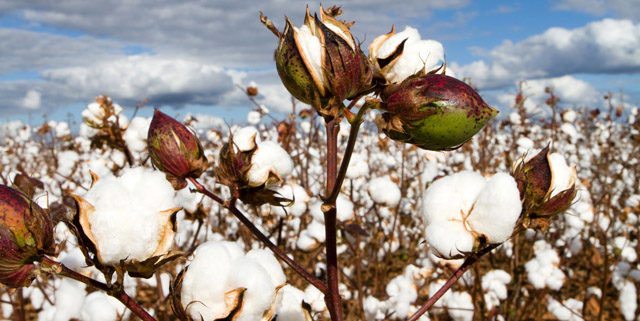RECENT PRICE MOVEMENT
After falling in July, benchmark prices were stable in August and the first half of September.
- The NY December contract has held to levels near 58 cents/lb since mid-August.
- The A Index was steady near 70 cents/lb.
- In international terms, the China Cotton Index (CC Index 3128B) decreased from 88 to 83 cents/lb between early August and the present. Over the same period, the RMB eased 0.9% against the USD (from 7.05 to 7.12 RMB/USD).
- Indian cotton prices (Shankar-6 quality) traded consistently near 75 cents/lb in international terms over the past month. In domestic terms, Indian prices held to levels between 41,500 and 42,700 INR/candy. Over the same period, the INR declined 1.2% against the USD (from 70.8 to 71.7 INR/USD).
- Pakistani prices increased from 60 to 63 cents/lb in international terms and from 7,750 to 8,100 PKR/maund in domestic terms. The PKR strengthened against the dollar over the past month (+1.4%, from 158.3 to 156.2 PKR/USD).
SUPPLY, DEMAND, & TRADE
The latest USDA report featured decreases to world production and mill-use figures. The global harvest forecast for 2019/20 dropped 709,000 bales to 124.9 million, and the consumption forecast fell 1.3 million bales to 121.7 million. Along with an increase in beginning stocks (+503,000 bales to 80.0 million), the larger decrease in mill-use relative to production resulted in a 1.3 million bale addition to the projection for world ending stocks in 2019/20 (to 83.7 million bales).
Virtually all the additional accumulation in global stocks is expected to occur outside China. The prediction for ending stocks for the world-less-China is now 50.0 million bales (+1.3 million bales relative to the August forecast). If realized, this would represent the largest volume of cotton held outside China on record (previous records set in 2018/19 at 45.1 million and 2017/18 at 43.0 million).
The largest country-level production revisions included those for the U.S. (-654,000 bales to 21.9 million), Australia (-500,000 bales to 1.4 million), India (+500,000 bales to 29.5 million), Burkina Faso (-150,000 to 1.0 million), Mexico (-100,000 to 1.6 million), and Turkmenistan (-100,000 to 1.2 million). With this month’s reduction, Australia is forecast to grow the least amount of cotton since 2007/08. The projection of 1.4 million bales in 2019/20 represents less than 30% of the 4.8 million bales grown in 2017/18 (the harvest was 2.2 million in 2018/19).
The largest country-level revisions for mill-use included those for China (-500,000 bales to 39.5 million), Bangladesh (+300,000 to 7.4 million), Brazil (-200,000 to 3.4 million), India (-250,000 to 24.8 million), Thailand (-125,000 to 1.0 million), Turkey (-100,000 to 6.8 million), the United States (-100,000 to 3.0 million), and Vietnam (-100,000 to 7.5 million).
In terms of imports, the largest changes were for India (+200,000 bales to 1.6 million), Vietnam (-200,000 to 7.6 million), Pakistan (-100,000 to 2.9 million), Thailand (-125,000 to 1.1 million), and Turkey (-100,000 to 3.1 million).
In terms of exports, the largest changes were for the U.S. (-700,000 bales to 16.5 million), Brazil (+500,000 to 8.5 million), India (-200,000 to 4.0 million), Mexico (-100,000 to 0.5 million), Australia (+100,000 to 1.9 million), and Burkina Faso (-100,000 to 0.9 million).
PRICE OUTLOOK
The U.S.-China trade dispute escalated further over the past month. In mid-August, the U.S. detailed plans for increasing tariffs on all goods that had not been covered by previous rounds of increases. The goods affected include apparel (HS Chapters 61 and 62) and home textiles (HS Chapter 63).
This next round of tariff increases is scheduled to occur in two stages. The first stage (List 4a), which covers product categories where China’s share is less than 75%, was implemented on September 1st. The second stage (List 4b) covers goods where Chinese share exceeds 75%; its implementation is scheduled for December 15th.
Initially, the increase in tariffs for both List 4a and 4b was set at ten percentage points. However, China responded by announcing additional tariff increases on goods it imports from the U.S. This included an additional five percentage point in duties applied to its imports of U.S. cotton. If implemented as planned on December 15th, it will bring the total increase in tariffs on U.S. cotton shipments to thirty percentage points (e.g., from one percent to thirty-one percent).
The Chinese response prompted the U.S. to announce steeper increases (another five percentage points) on tariffs on goods it imports from China. Coverage spans earlier rounds of increases (Lists 1, 2, and 3 where tariffs increases will rise from 25 to 30 points) as well as Lists 4a and 4b (where tariffs will increase will rise from 10 to 15 points).
Most recently, there have been small reconciliatory steps made ahead of talks planned for early October. The U.S. agreed to delay the implementation of the five-point increases on Lists 1, 2, and 3 (mostly non-consumer goods) from October 1st to October 15th and China agreed to lift the twenty-five-point increases in duties (put into place in 2018) on a small subset of goods for one year.
All the above developments emerged over the past month. The ability for the tariff dispute to change so quickly has been a significant source of uncertainty across cotton supply chains. Uncertainty can postpone investment and order placement, and therefore can slow demand.
Many of the world’s largest economies have been experiencing slower growth over the past year. Although its relative influence as a contributing factor is a source of debate, the onset of the U.S.-China trade dispute was coincident with the time that economic forecasts began turning lower (spring of 2018). Whether or not a resolution is found or whether uncertainty and escalation continue can be expected to influence macroeconomic conditions, cotton demand, and cotton prices.
